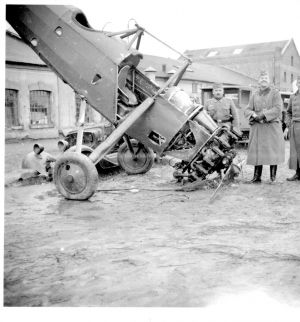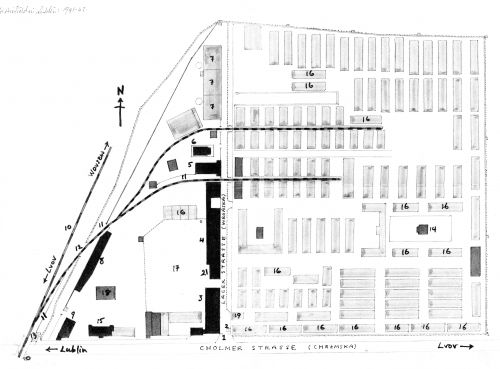Lublin Old Airfield

Lublin Old Airfield - German Troops 1939
The Lublin (Alter Flugplatz) camp was named after its location on the airfield of the former aircraft manufacturer E. Plage and T. Laskiewicz near Lublin on ul. Wronska to the north of the Lublin concentration camp. It was part of a system of camps and warehouses at the site, which included the Nachbaulager Russland-Sud and the main supply camp for the Higher –SS and Police Leader (HSSPF) Russland –Sud und Kaukasien.
The use of Jewish labour at the Old Airfield began July – August 1940 with the establishment of a forced labour camp for Jews. During the summer of 1942, the camp was significantly expanded and became part of the close economic co-operation between the SS-Business Administration Main Office (WVHA), headed by Oswald Pohl and SS- Brigadeführer Odilo Globocnik the SS and Police Chief (SSPF) of the Lublin District. Both parties were interested in working with one another. Globocnik, in intensifying the exploitation of Jewish forced labour in the Lublin region and in the profitable recycling of the property of deported and murdered Jews. Pohl was interested in increasing the efficiency of the SS economic enterprises. This resulted in 1942 -1943 not only in increased concentration and exploitation of the Jews in the Lublin region under the control of the WVHA but in the formation of the Ostindustrie GmbH (Osti), a company jointly owned by the WVHA and SSPF. In this joint venture, Pohl secured authority over the Jewish workers, and Globocnik secured functional control of the camp, particularly because he appointed his confidants to key positions in it. The Old Airfield camp was one of the camps where this co-operation was practiced.

Lublin Old Airfield Drawing (Mike Tregenza)
In 1942, the rapidly developing Deutsche Ausrustungswerke GmbH (German Equipments Works, DAW), opened a tar-paper factory on the premises of the former airstrip and the next year it set up shoe repair shops, launched the production of shoe soles and munitions boxes. The SS Clothing Works (SS-Bekleidungswerke) was set up in the summer of 1941, on the premises of the former Lublin Aircraft Factory. Initially, women prisoners from the Lublin Castle prison and Jewish specialists from the Lublin ghetto were employed there. The Clothing Works developed production on a large scale, since Heinrich Himmler (RFSS), in a note of 21 July 1941, instructed the SS storehouses to place their orders there. In March 1942, the SS Clothing Works was again placed under Globocnik’s administration. From then on, the enterprise was to engage in the segregation, disinfection, and shipment to the Reich of the property of the murdered Jews in the former aircraft hangers. The property came from the three ‘Aktion Reinhardt’ camps of Belzec, Sobibor and Treblinka. Additionally property was sent to the Alter Flughafen camp from nearby camps and ghettos, which was served by an excellent rail link, that facilitated the arrival of property from the death camps and the dispatch of property to the Reich. In connection with this re-organisation and in order to conceal the true nature of the true character of the Clothing Works activities, SS- Hauptsturmführer Friedrich Opitz was replaced as the works manager by SS- Hauptsturmführer Josef Obermeyer, one of Globocnik’s trusted officers. Obermeyer was tasked with expanding the camp. While in 1942, there were about 300 women in the camp, and 5,000 male prisoners, who were separated from the female prisoners.
While the women were mostly used to sort and recycle clothing, the men were used primarily to sort, recycle and recast unusable household appliances and furniture. Starting in November 1942, about 4,000 women had to perform hard physical labour, including paving runways. In the women’s camp there was no running water and no sewage, and electricity was only available at the job sites. Many of the female overseers had come from Lublin concentration camp, among them Charlotte Mayer. The origins of the prisoners are mainly unknown, although in 1942, most of the prisoners were from the Majdan Tatarski ghetto, which was located a short distance from the camp. The ghetto was liquidated in November 1942, and most of the prisoners then came from liquidated labour camps and ghettos from a wider range, with some even coming from Germany and Holland. Former Jewish property was sold here to German officers and citizens in Lublin as well as being sent to Germany.
On 22 October 1943, the camp became a sub-camp of the Lublin concentration camp, although two weeks later on 3 -4 November 1943, all the prisoners were liquidated as part of the ‘Aktion Erntefest’ (Harvest Festival). They were marched to the nearby Lublin concentration camp and murdered in specially dug mass graves.
SOURCES:
The Encyclopaedia of Camps and Ghettos 1933-1945, Volume 1, USHMM ,Indiana University Press Bloomington and Indianapolis 2012
J. Marszalek, Majdanek – The Concentration Camp in Lublin, Interpress, Warsaw, 1986
Photograph: Chris Webb Archive
Drawing - Mike Tregenza
© Holocaust Historical Society 2019



